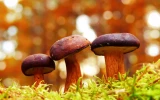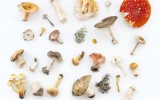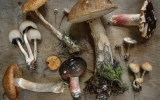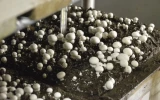25 Most Common Mushroom Types (With Pictures)
This guide introduces you to the most common types of edible mushrooms with pictures. Each type has its own distinct taste and culinary uses, making them a popular find at your local farmers market. Whether you're a cooking enthusiast or just curious about these intriguing forms of fungi, you'll find this overview a great starting point to explore the diverse world of mushrooms.
The most common mushroom types include the versatile and mild White Button, the slightly richer Cremini, the large and meaty Portobello, and the woody-flavored Shiitake. Each type offers unique flavors and textures, making them popular choices for a variety of dishes.
Here's the twist: while these are the stars of the culinary world, there's a wild variety out there, like the enchanting Morel and the vibrant Chanterelle, that gourmet chefs dream about.
Summary
- Beyond their culinary versatility, mushrooms are lauded for their health benefits, providing essential nutrients like B vitamins, selenium, potassium, and fiber. Some, like reishi and turkey tail, are also known for medicinal properties, supporting immune function and overall health.
- Many mushroom varieties, such as chanterelles, morels, and black trumpets, are popular targets for foragers. Correct identification is crucial for safety, as there are toxic lookalikes for some species.
- Proper storage extends the shelf life of mushrooms, with recommendations including keeping them in the refrigerator in paper bags to absorb excess moisture. Some mushrooms, like porcini, can be dried for long-term storage, offering a concentrated flavor that is valuable in cooking.
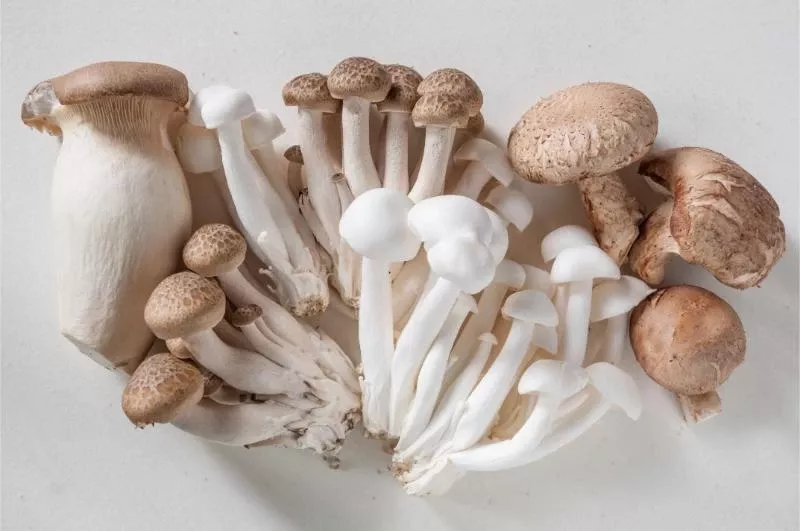
On this page:
- White Button (Agaricus bisporus)
- Cremini or Baby Bella (Agaricus bisporus)
- Portobello (Agaricus bisporus)
- Shiitake (Lentinula edodes)
- Oyster (Pleurotus ostreatus)
- Enoki (Flammulina velutipes)
- Chanterelle (Cantharellus cibarius)
- Morel (Morchella esculenta)
- Porcini (Boletus edulis)
- King Oyster (Pleurotus eryngii)
- Maitake or Hen of the Woods (Grifola frondosa)
- Beech or Shimeji (Hypsizygus tessellatus)
- Wood Ear (Auricularia auricula-judae)
- Lion's Mane (Hericium erinaceus)
- Puffball (Lycoperdon perlatum)
- Turkey Tail (Trametes versicolor)
- Reishi (Ganoderma lucidum)
- Black Trumpet (Craterellus cornucopioides)
- Hedgehog or Sweet Tooth (Hydnum repandum)
- Truffle (Tuber genus)
- Russula (Russula spp.)
- Caesar's Mushroom (Amanita caesarea)
- Gypsy Mushroom (Cortinarius Caperatus)
- Saffron Milk Cap (Lactarius Deliciosus)
- Cloud Ear (Auricularia Polytricha)
Edible mushrooms come in a vast array of shapes and sizes. You might have encountered the common button mushroom in many dishes, but beyond that, there are numerous other types that can add depth and character to your meals.
Whether you're folding them into a creamy risotto or sautéing them for a side dish, the mushrooms' unique flavors and textures can make your ordinary meal extraordinary.
You'll find that certain mushrooms are perfect for absorbing flavors, like the spongy morels, while others, such as shiitakes, offer a woodsy essence to stir-fries and soups. This diversity not only broadens your palate but also introduces you to the many health benefits mushrooms offer.
Now, let's take a closer look at some of the most common mushroom types and how you can incorporate them into your culinary adventures.
White Button (Agaricus bisporus)
White button mushrooms are loved for their mild flavor and versatile use in cooking. They are the young form of the Agaricus bisporus species. These mushrooms are small, with pale white caps, and you'll often find them enhancing the taste of various dishes.

-
Cooking: You can enjoy white button mushrooms raw in salads or cooked in a plethora of dishes. They absorb flavors well, making them a perfect addition to your meals. Whether sautéed as a side or tossed into a burger, their semi-firm texture provides a satisfying bite.
-
Uses: These mushrooms are a staple for vegetarian cooking, appreciated for their nutritional benefits and meaty texture. You can use them as a main ingredient or to complement other components in your dish. Their presence is subtle, but they enrich the meal with umami notes without overpowering other flavors.
-
Preparation tips: To prepare, you just need to give them a quick rinse and pat them dry. They can be sliced for salads, diced for sauces, or even stuffed for appetizers. Their mild taste and easy preparation make white button mushrooms a favorite choice for cooks at all levels.
Cremini or Baby Bella (Agaricus bisporus)
Cremini mushrooms, also known as Baby Bella mushrooms, are a variety of Agaricus bisporus. They are essentially young Portobello mushrooms and are recognized for their smooth, rounded caps and firm, meaty texture.
When you pick cremini mushrooms at the store, look for firm, plump specimens with a uniform color. Make sure they are free from spots and blemishes. Store your cremini mushrooms in the refrigerator, and they will stay fresh for your upcoming meals.
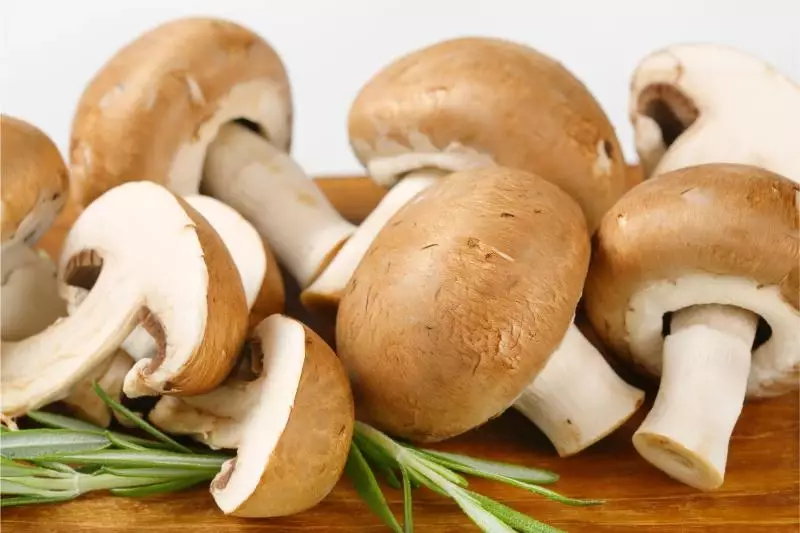
-
Appearance: The appearance of cremini mushrooms is characterized by their slightly larger size compared to white button mushrooms, ranging in color from light to rich brown. They feature a small, round cap with a short stem, adding to their distinct appearance.
-
Usage in cooking: Baby bella mushrooms are versatile in cooking and can withstand various cooking methods such as sautéing, roasting, and grilling. They are perfect for adding to pastas, soups, and stir-fries, providing a depth of flavor and a satisfying chewiness that enhances the overall taste of many dishes.
-
Nutritional profile: Cremini or baby bella mushrooms have a nutritional profile that is low in calories while being packed with essential nutrients such as selenium and B vitamins.
Portobello (Agaricus bisporus)
Portobello mushrooms are known for their large size and meaty texture, making them a popular choice for a range of dishes. You'll find that their robust flavor pairs well with a variety of ingredients, which is why they are often used as a meat substitute in meals. If you're looking to cut down on meat or just want to try something new, portobellos are a great option.
When it comes to preparation, stuffed portobello mushrooms are a favorite. You can fill them with anything from cheese and breadcrumbs to quinoa and veggies for a satisfying entree. For a hearty and healthy option, they can also be grilled and used as a stand-in for beef in burgers, giving you that savory taste with fewer calories.

Here's a quick guide to help you enjoy portobellos:
- Selection: Choose mushrooms with firm, smooth caps and a fresh appearance.
- Storage: Keep them in the refrigerator in a paper bag.
- Preparation: Wash gently or wipe with a damp cloth before cooking.
With their versatility in the kitchen, portobellos are an excellent addition to your culinary repertoire. Whether sautéed, roasted, or grilled, they offer a delightful umami flavor that enhances your dishes.
Portobellos are not just delicious; they are also packed with nutrients like B vitamins and potassium, as found in this comprehensive nutrition breakdown.
Shiitake (Lentinula edodes)
Shiitake mushrooms, scientific name Lentinula edodes, are a staple in Asian cuisine. They grow on hardwood trees and are especially associated with oak, chestnut, and beech. These mushrooms have a naturally occurring umami flavor, which is one reason why they're so popular in cooking.
When selecting shiitake mushrooms, look for ones with an earthy aroma and smooth, crack-free caps. Their texture is dense and meaty, perfect for adding a substantial bite to your dishes. Be aware that the stems can be tough; they're best used in making flavorful broths.
In the kitchen, shiitakes are incredibly versatile. They can be stir-fried, sautéed, used in soups, or even grilled. To maximize their rich, woodsy taste, cook them until they're slightly crispy on the edges. Your culinary creations will burst with the savory notes that only shiitake mushrooms can provide.

Preparation tips for shiitake mushrooms:
- Sautéing: Brings out their natural umami.
- Stir-frying: Keeps them crisp and tender.
- Grilling: Offers a smoky flavor.
- Broth: Stems enhance soups and stocks.
Oyster (Pleurotus ostreatus)
Oyster mushrooms are a diverse group that you'll find delightful in vegetarian dishes thanks to their meaty texture. There's a range of varieties, each with unique characteristics. For instance, the golden oyster mushroom has a vibrant yellow color, and despite its quick growth, it's not commonly found in mass markets.
Here’s a quick look at some notable types:
- Pearl Oyster: Exhibiting a tender feel with a mild, slightly sweet flavor, Pearl Oysters are small with a sparse stem. These are common and versatile.
- King Oyster: Recognized for their thick white stems and small flat caps, these mushrooms offer a heartier chew, perfect for your savory cravings.
Oyster mushrooms grow on dead trees and are easily identifiable by their fan-shaped caps with gills that extend down to the stem. They enjoy a reputation for a rich, earthy taste that can sometimes be described as having hints of anise or licorice.
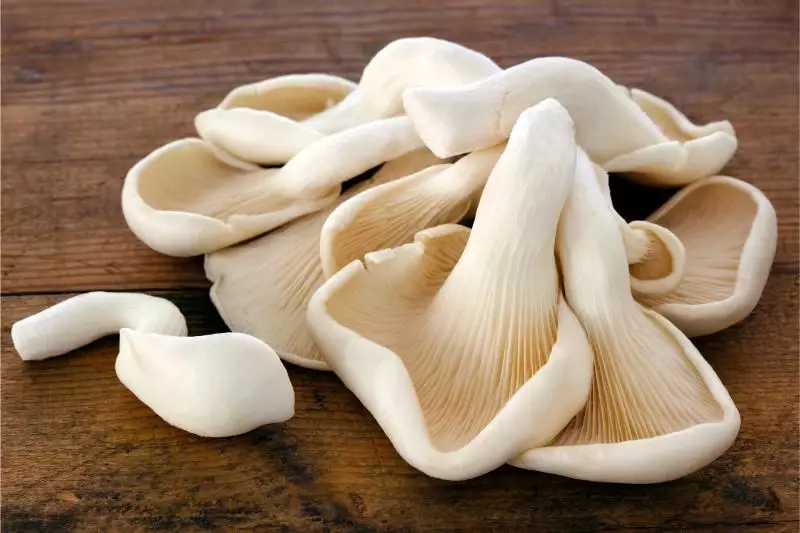
To know more about the oyster mushroom growth stages, read this article.
Cooking tips:
- Texture: Aim to preserve their meaty consistency for a satisfying bite.
- Flavor: Mild seasonings complement their naturally savory profile.
Lastly, if you're looking into cultivation, oyster mushrooms are a fantastic starting point. They’re less challenging to grow at home than other types, potentially offering you a delightful harvest.
Reminder: Always ensure you're foraging or purchasing from a reputable source to guarantee safety and quality.
Enoki (Flammulina velutipes)
The Enoki mushroom, also known as Flammulina velutipes, is a distinct variety that you're likely to come across. It’s recognized by its notably long, thin stems topped with small caps, usually sold in clusters. Originating from East Asia, these mushrooms have a mild, slightly sweet taste and a crunchy texture that adds a delightful bite to your meals.
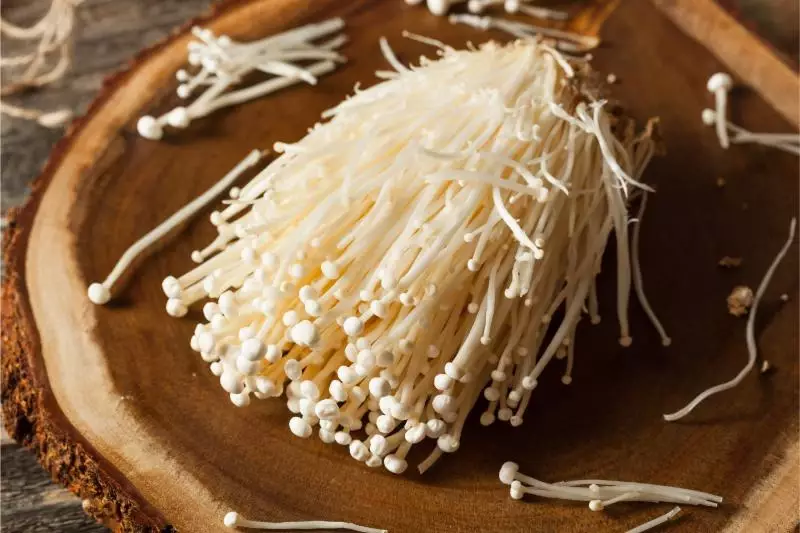
When it comes to cooking, enoki mushrooms are versatile. They can be a delicious side or a main ingredient in various dishes. Commonly included in Asian cuisines, they’re particularly great in stir-fries, soups, and salads. To use them, simply trim off the bottom and separate the stems.
When storing enoki, keep them in your refrigerator to maintain their freshness. Make sure that they’re dry, as excess moisture can make them spoil faster. With their unique texture and flavor, enoki mushrooms can brighten up your dishes and offer a nutritious boost.
Chanterelle (Cantharellus cibarius)
Chanterelle mushrooms are easily spotted by their vibrant golden hue and their unique, trumpet-like shape. When you find them in the wild, you'll see the wavy edges that taper down to the stalk. Their false gills appear as forked folds rather than the separate gills found on other mushrooms, which helps distinguish them when foraging.

- Identification: When identifying chanterelle mushrooms, it is important to note that they typically exhibit a deep golden to yellow coloration. Their shape resembles a trumpet, with wavy margins adding to their distinctive appearance. Additionally, chanterelles are characterized by false gills that resemble forked folds, further aiding in their recognition.
Chanterelles emit a sweet and fruity aroma, which is quite pleasant. When cooked, they offer a nutty and mild peppery flavor that adds depth to your dishes. They are not just sought after for their taste but also for their versatility in the kitchen.
- Taste profile: The taste profile of chanterelle mushrooms is characterized by a sweet, fruity smell and a nutty, mildly peppery flavor. In terms of texture, they are described as meaty and chewy, adding to their overall appeal in culinary applications.
Interestingly, chanterelles were once all classified under one species, Cantharellus cibarius. However, recent studies have revealed a diversity within the group. Now, it’s known that what was thought to be Cantharellus cibarius doesn’t occur in the US, and multiple species are present.
Chanterelles grow in partnership with trees, drawing nutrients from the soil and helping the tree in return. They are most commonly found in hardwood forests, particularly amidst oak and conifer trees.
- Habitat: Chanterelle mushrooms are typically found in association with hardwood and conifer trees, thriving in moist, well-drained soils. This specific habitat provides the ideal conditions for the growth and development of these sought-after fungi.
Morel (Morchella esculenta)
Morels are treasured among mushroom varieties for their distinctive appearance and flavor. Distinguished by their honeycombed caps, morel mushrooms offer a meaty texture that's celebrated in gourmet cooking. When foraging for morels, you'll encounter several species, characterized mainly by their unique colors and sizes.
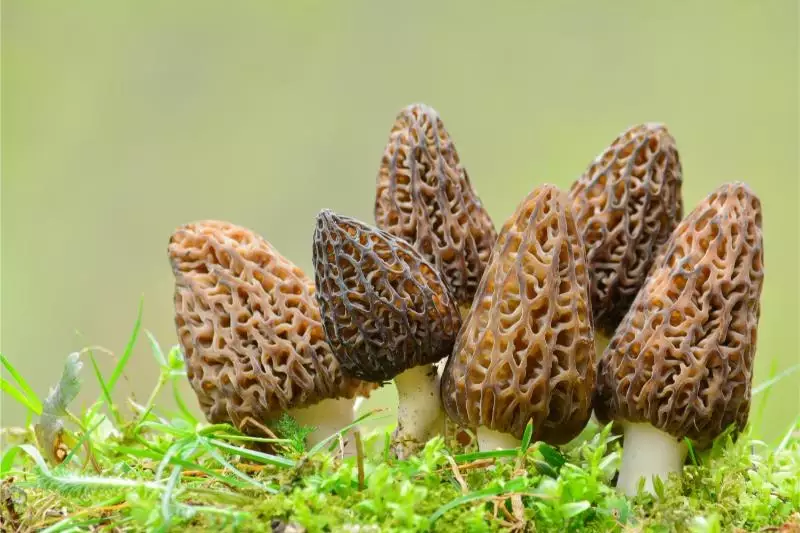
- Colors: Black, Yellow, Gray
- Texture: Meaty and earthy
- Habitat: Woodlands, usually near ash, elm, and apple trees
You may come across various types in your foraging adventures:
| Common Morels | Scientific Names |
|---|---|
| Black Morel | Morchella angusticeps, Morchella conica |
| Yellow Morel | Morchella deliciosa, Morchella esculenta |
| Half-Free Morel | Morchella semilibera, Morchella punctipes |
These delightful mushrooms are often sought after in the spring. Because of their elusive nature, finding morels can be the highlight of any mushroom hunter's season. Ensure you can identify true morels, as they have a hollow stem, unlike false morels which are not hollow and can be toxic.
If you're cooking morels, make sure to cook them properly. Their unique flavor and texture make them a gourmet addition to dishes like pastas, risottos, and as a side to a well-cooked steak.
Porcini (Boletus edulis)
Porcini mushrooms, also known as Boletus edulis, are renowned for their rich, earthy flavor that enhances dishes like risotto and pasta. These mushrooms are identified by their brown convex caps and thick white stalks, and can be found fresh or dried for various culinary uses.
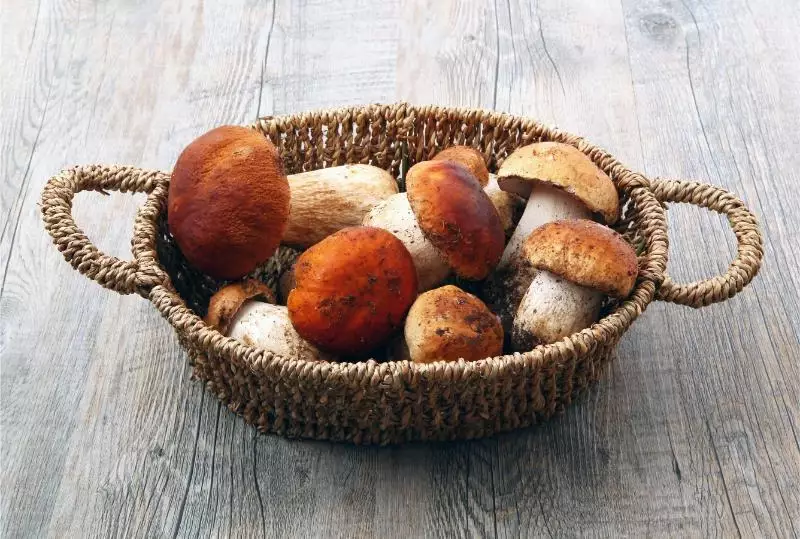
-
Habitat and season: Porcini thrive in coniferous forests and are typically foraged from late summer to fall. When dried, porcini offer a more concentrated umami flavor, making them valuable in cooking.
-
Culinary uses: Porcini are widely celebrated for their contribution to the rich flavors of many beloved Italian dishes. When using fresh porcini, sautéing or grilling them is recommended to bring out their delightful nutty taste. On the other hand, dried porcini mushrooms are perfect for enhancing broths, imparting a deep and satisfying umami flavor to the culinary creations.
-
Preparation tips: For fresh porcini, clean them gently with a brush; when using dried, soak them first to rehydrate. Remember to save the soaking water to infuse your dishes with extra flavor.
King Oyster (Pleurotus eryngii)
If you're exploring the world of mushrooms, king oyster mushrooms are a delightful variety you might encounter. Known scientifically as Pleurotus eryngii, they are prized for their thick, meaty stems and a savory flavor that makes them stand out. Your vegetarian or vegan recipes can significantly benefit from their meat-like texture, which holds up well to cooking.
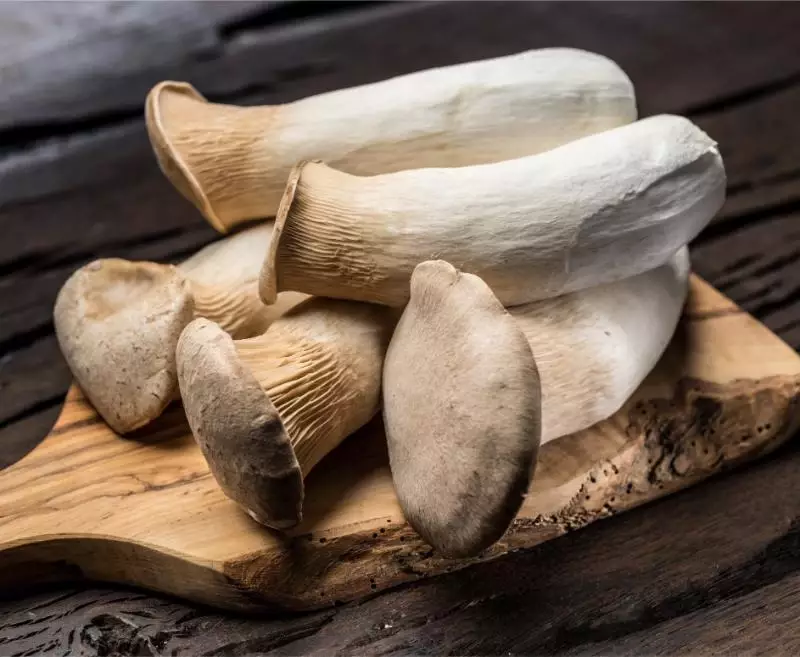
What are the ideal fruiting conditions for king oyster mushrooms? Find out here.
King oysters are distinct from other oyster mushrooms due to their large size and unique shape. Here are some attributes that define this mushroom:
- Cap size: Often 3-12 cm
- Stem: Thick and white, ranging from 3-10 cm
- Gills: Grey, thin, and distant
- Texture: Firm and meaty
Their hearty constitution means you can slice them into rounds and pan-sear them for a substitute to sea scallops, or even grill them for a smoky flavor. They're also commonly used in Asian cuisines, mimicking meat in stir-fries and other dishes.
To get your hands on these mushrooms, check out local farmers markets or specialty stores. Whether you choose to buy or grow your own, king oysters are a versatile ingredient that will elevate your culinary endeavors. Their ability to adopt the flavors they're cooked with will make them a staple in your kitchen, especially if you follow a plant-based diet.
Maitake or Hen of the Woods (Grifola frondosa)
Maitake mushrooms, known as Hen of the Woods, are a culinary delight you might want to try. With their rich and savory flavor, they make an excellent meat substitute in various dishes. These mushrooms possess a distinctive rosette-like appearance, with clusters of overlapping caps that can range from light brown to grayish-white.
| Attribute | Description |
|---|---|
| Scientific name | Grifola frondosa |
| Common names | Hen of the Woods, Sheep's Head, Ram’s Head |
| Flavor profile | Savory, earthy |
| Texture | Firm, slightly chewy |
These mushrooms are not only a treat for your palate but also a forager's trophy. They tend to grow at the base of oak trees, but you might also find them near elms and maples. They are a polypore fungus, which means they do not have gills like other mushroom varieties.
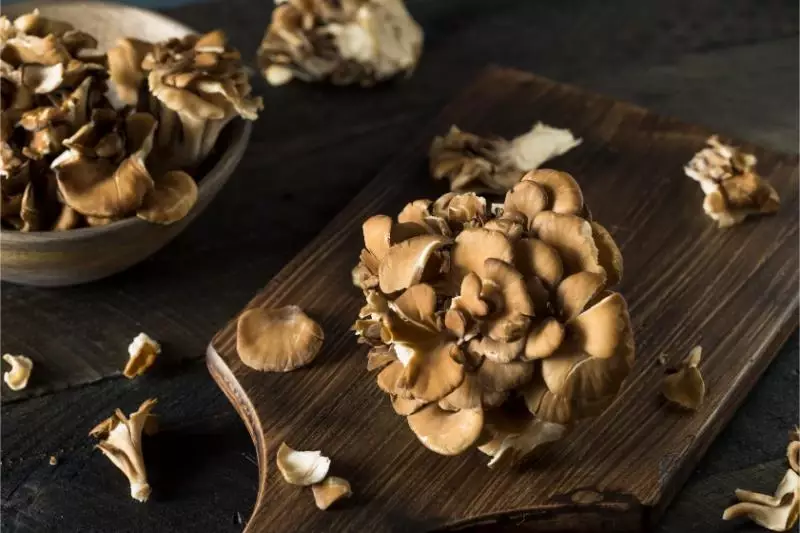
When you're cooking with maitake, remember that their hearty texture holds up well to sautéing, grilling, and roasting. Their full-bodied taste enhances soups, stews, and stir-fries.
When substituting maitake for meat, you can expect a substantial bite and umami-packed flavor that enriches your meals. If you're eager to explore its uses, you can find guidance on how to integrate maitake mushrooms into your cooking.
Beech or Shimeji (Hypsizygus tessellatus)
Beech mushrooms, categorized as shimeji, are a group you might often encounter in Asian cuisine. They are known for their sweet and somewhat nutty flavor. These mushrooms typically come in two main colors: white and brown.
The edible variety of these mushrooms can easily elevate your dishes with their distinct taste. Common types include white beech or Bunapi-shimeji and the brown variety known as Buna-shimeji. They're often sold in clusters with a base that needs to be trimmed before cooking.
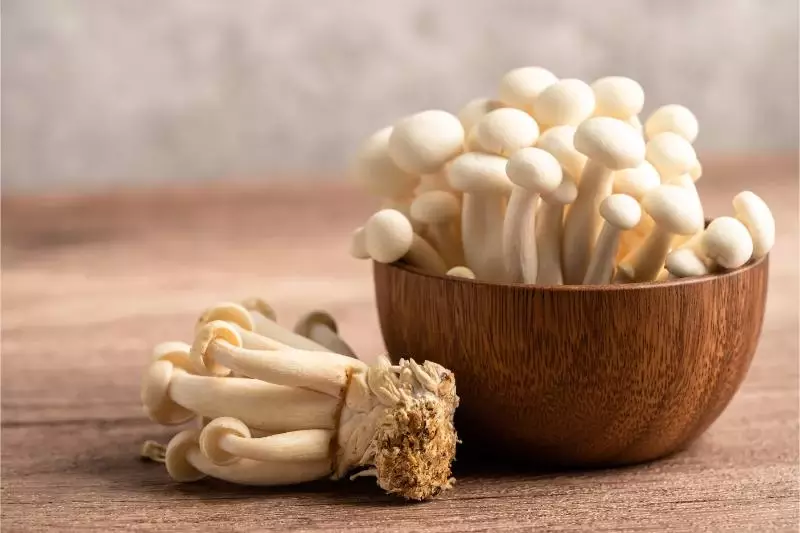
To prepare beech mushrooms for your meal, you'll want to separate the individual stems after cutting off the inedible base. Both the caps and stems are edible, bringing a firm yet slightly crunchy texture to your dish. Here's a simplified way to get these ready for cooking:
- Trim the base where the mushrooms are joined.
- Gently separate the stems.
- Rinse lightly and they're ready to use.
Enjoy them sautéed, in soups, or stir-fries where their flavor can enhance the depth of your culinary creations. Cooking shimeji mushrooms is best done at moderate heat to preserve their delicate savory notes. Whether you're a seasoned chef or a home cook, incorporating beech mushrooms into your recipes can add an interesting twist to familiar flavors.
Wood Ear (Auricularia auricula-judae)
Wood ear mushrooms, identified by their unique ear-like shape, are a popular ingredient in Asian cuisine. They have a distinctive, gelatinous texture which becomes noticeable when you add them to dishes like soups and stir-fries. Known for their ability to absorb flavors, wood ears are often paired with garlic, ginger, and soy sauce.
Preparing wood ear mushrooms is quite straightforward. First, rehydrate them in water if they're dried. You'll find that they expand and become more elastic. After they're rehydrated, slice them into thin strips and cook as desired.
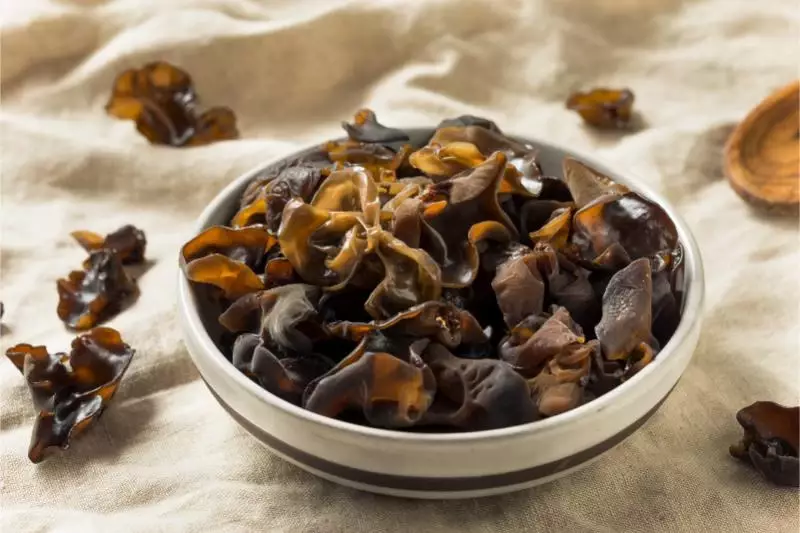
Nutritionally, wood ears are low in calories yet rich in fiber. They also contain small amounts of protein and iron. When foraging for wood ears, ensure correct identification as there are lookalikes that are not edible. For a safer option, you can purchase these mushrooms from a reputable store or forage with an expert.
Wood ear mushrooms have multiple species, with the black wood ear or jelly ear being among the most common. Enjoy incorporating wood ears into your cooking to bring a bit of Asian flair and a chewy texture to your meals.
Lion's Mane (Hericium erinaceus)
Lion's Mane is a unique mushroom that stands out from other mushroom varieties due to its appearance and texture. With a shaggy, white exterior resembling a lion's mane, this mushroom is both a visual and culinary delight.
Characterized by its long, soft spines, Lion's Mane mushrooms have a meaty texture that can mimic seafood like lobster and crab. When cooked, its mildly sweet flavor and tender consistency make it a favored choice for plant-based dishes mirroring the taste of seafood.

If you want to learn how to grow lion's mane successfully, read this article.
Nutrition and cooking:
- Flavor: Mildly sweet
- Texture: Meaty, similar to shellfish
- Uses: Ideal for seafood alternatives
Enjoy Lion's Mane sautéed, roasted, or stewed; it absorbs flavors well, making it versatile for your kitchen experiments. When these mushrooms age, their color transitions from white to brown or yellow, but they are still good to eat. Your adventure with Lion's Mane mushrooms holds a unique experience not just for your palate, but also for your plate's presentation.
Puffball (Lycoperdon perlatum)
Puffball mushrooms are a fascinating group with a distinctive round appearance. When young, their interiors are white and solid, suitable for eating. Giant puffball mushrooms can reach impressive sizes, sometimes as large as a basketball.
These mushrooms are recognized for their mild flavor, which makes them a versatile ingredient in your kitchen. They can be sautéed, grilled, or even used in soups and stews. Nutrition-wise, puffballs contain a variety of nutrients including protein, fiber, and vitamins, though specific quantities vary by species and size.

To safely enjoy puffball mushrooms, proper identification is crucial. Ascertain that the inside is uniform and white, as older puffballs with spore mass or discoloration are not edible.
| Feature | Detail |
|---|---|
| Shape | Round and smooth, inflating like a ball |
| Color | White when young, becomes yellowish with age |
| Size | Ranging from small to very large (giant puffball) |
| Flavor | Mild, blending well with various dishes |
| Edibility window | When the inside is homogeneously white and firm |
Turkey Tail (Trametes versicolor)
Turkey tail mushrooms, scientifically known as Trametes versicolor, are easily recognized by their circular, overlapping groups that resemble a wild turkey's plumage. These mushrooms exhibit a beautiful array of colors from grey to brown, with bands of blue, green, and red.
-
Physical characteristics: The turkey tail mushroom has a fan-like shape, reminiscent of turkey feathers, and a typical diameter ranging from 2 to 8 cm. Its surface is velvety to the touch, often adorned with concentric rings displaying an array of colors.
-
Identifying tips: When identifying turkey tail mushrooms, it's important to look for the distinct multi-colored concentric rings on the cap. Additionally, check the underside for small pores, as true turkey tails have tiny holes instead of gills. Lastly, feel the cap, which should be leathery and flexible.

Turkey tail mushrooms grow on dead logs, stumps, and branches, preferring hardwoods. They are widespread, found in forests throughout the world. You might also encounter mushrooms that look similar to turkey tails, like the Stereum ostrea. To differentiate, note that Stereum species typically lack a velvety texture and pores on the underside.
- Uses: Turkey tail mushrooms have a range of uses, including their traditional medicinal use where they are believed to support immune function. Additionally, they play a crucial ecological role as decomposers, aiding in the breakdown of wood.
Reishi (Ganoderma lucidum)
Reishi mushrooms, revered in Eastern medicine, are a type of polypore. These mushrooms grow on wood, such as stumps or logs, and are never found growing freely on the ground. They offer various health benefits and are often called the "mushroom of immortality."
When you encounter a reishi mushroom, you'll notice its distinctive texture. The mushroom is tough and woody, making it different from the typical button mushroom. You can't cook reishi like other edible mushrooms because of its hardness.

Here's a quick identification tip: Reishi has a white spore print, which you can observe by placing the cap on paper overnight. Additionally, these mushrooms prefer certain types of trees. For example, the Ganoderma tsugae species has an affinity for conifers, particularly hemlocks.
When preparing reishi, it is commonly used in dried form. You can simmer reishi in water for an extended period, often several hours, to create a herbal tea. This method softens the mushroom and allows its properties to infuse into the liquid.
If you're interested in integrating reishi into your wellness routine, it's widely available in various forms. You can find reishi as dried slices, powders, tinctures, and more at health stores or online. Consult your healthcare provider for advice on using any herbal supplements.
Black Trumpet (Craterellus cornucopioides)
Black trumpet mushrooms, or Craterellus cornucopioides, are a cherished find for culinary enthusiasts. Their unique trumpet-like shape and dark color make them stand out. Growing in hardwood forests, these mushrooms are identifiable by their hollow, funnel-like form.
The flavor of black trumpets is deeply earthy with a hint of smokiness, making them a prized addition to your dishes. They are particularly well-suited for sauces and risottos where their rich flavor can shine through. Due to their delicate texture, it's best to add them late in the cooking process.
Foraging for black trumpets can be a delightful, albeit challenging, activity. You can identify and forage these mushrooms by looking for their distinctive shape and color, primarily in late summer to fall. Always forage responsibly and ensure correct identification before consumption. To preserve their flavor, dehydrate or cook them soon after harvesting.
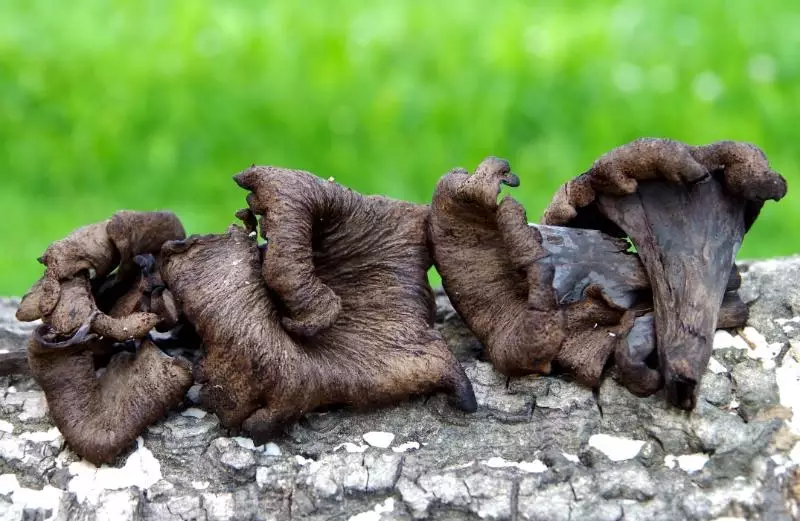
- Habitat: Hardwood forests
- Appearance: Dark, trumpet-like, hollow
- Taste: Smoky, earthy
- Uses in cooking: Soups, sauces, risottos
- Foraging tip: Best found late summer to fall
When you decide to cook with black trumpet mushrooms, you're adding a touch of gourmet flair. Embrace their unique taste and add a luxurious twist to your culinary creations.
Hedgehog or Sweet Tooth (Hydnum repandum)
Hedgehog mushrooms, also known as sweet tooth, are a delightful addition to your woodland foraging list. You can recognize them by their unique spiny gills underneath the cap, which resemble a hedgehog's quills. With their friendly appearance, they beckon foragers with their warm, nutty flavor.
Hydnum repandum is the formal name for these mushrooms. They boast a convex cap that flattens over time, often sporting a tawny to an orange-brown shade. You can be assured of simple identification as the hedgehog mushroom doesn't have poisonous lookalikes, making them a safer choice for novice foragers.
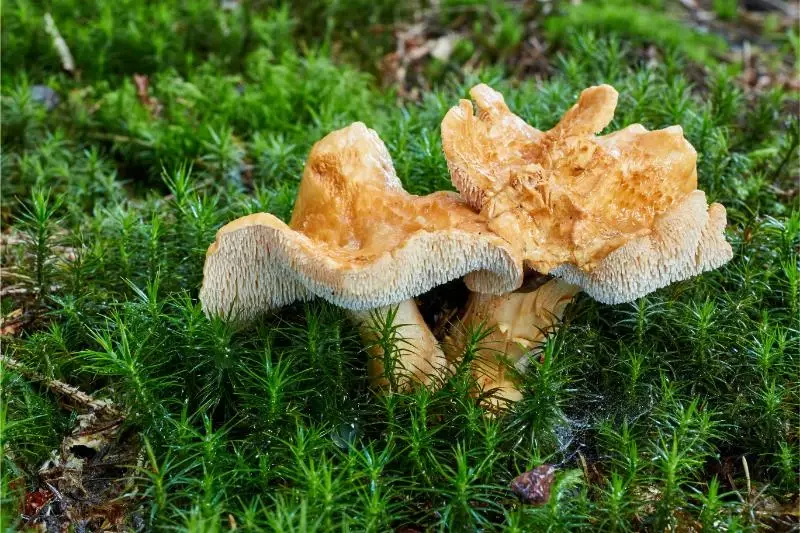
Here’s a quick guide to help identify hedgehog mushrooms:
- Cap: Creamy to light brown, often depressed in the center
- Spines: Can be plucked easily, under the cap
- Flesh: Firm, white
When you find hedgehog mushrooms, they're likely hiding under conifer trees or mixed woodland. They're not only charming to look at but also a delectable winter find, typically retailing at around [12–15] dollars per pound during the colder months. Whether sautéed or added to a hearty stew, hedgehogs bring a sweet, peppery flavor to the table.
Different species of hedgehogs may have specific habitats and emergence times. It’s wise to familiarize yourself with the local varieties in your area to harvest them at their best.
Truffle (Tuber genus)
Truffles are among the most luxurious ingredients in the gourmet culinary world. You'll find them in two primary varieties: white and black truffles. White truffles, known scientifically as Tuber magnatum, are highly prized for their complex aroma and are often more expensive than their black counterparts.
Black truffles (Tuber melanosporum) also bring a rich, earthy flavor to dishes. They are typically harvested in winter and have a robust taste that's cherished in many high-end dishes. You can enjoy both types of truffles shaved over pasta, risotto, or even used to infuse oils and sauces for an added touch of luxury to your cooking.
| Truffle Type | Season | Characteristics |
|---|---|---|
| White | Fall | Intense aroma, stronger flavor |
| Black | Winter | Earthy taste, firm texture |

To make the most out of your truffle experience, use them sparingly; their intense flavor means a little goes a long way.
When storing truffles, keep them in a dry and cool place, wrapped in paper towels to absorb moisture. This will help maintain their quality until you're ready to transform your dish into something truly extraordinary. Because of their rarity, truffles can be quite an investment, but their unique taste is often considered well worth the cost by culinary enthusiasts.
Russula (Russula spp.)
Russula mushrooms, often recognized by their vibrant caps, are a common foraging find. As you forage, you'll notice their hues vary from bright reds to oranges, and even to yellows and browns. With about 700 species globally, identifying them can be a fun but challenging activity.
When you're handling these mushrooms, you may notice their caps can be quite brittle. This characteristic, paired with their colorful appearance, often leads to them being called brittlegills. They have a wide variety of flavors and textures, which can range from nutty and mild to peppery and acrid.
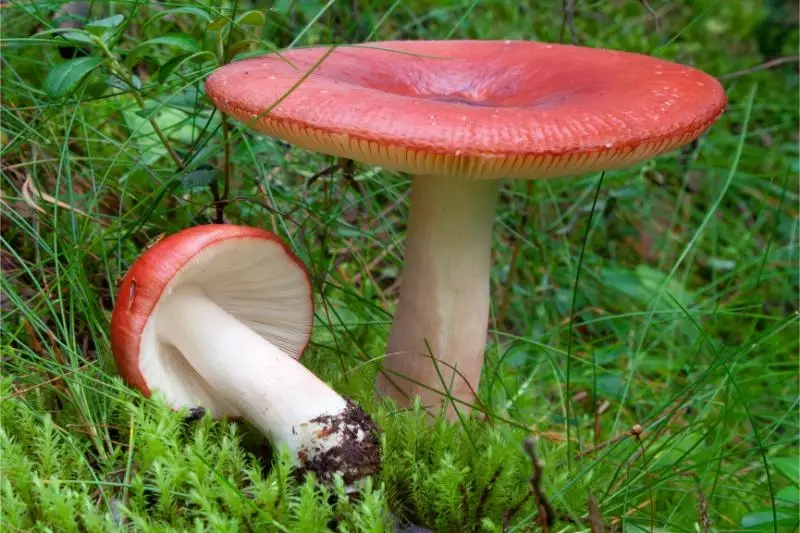
It's essential to be cautious, as russula mushrooms have both edible and inedible varieties. To safely enjoy your foraged russula, familiarize yourself with the species known to be safe for consumption. Some popular edible species include Russula cyanoxantha and Russula vesca, appreciated for their palatable taste.
| Edible Russulas | Characteristics |
|---|---|
| Russula cyanoxantha | Mild taste, bluish cap |
| Russula vesca | Sweet, nutty flavor, reddish cap |
When you're out in the wild, remember that proper identification is key. If you're new to foraging russula, consider going with an experienced forager or using a reputable guide to avoid any mishaps with inedible or toxic species.
Caesar's Mushroom (Amanita caesarea)
The Amanita genus includes a wide variety of mushrooms, which range from highly toxic to edible delicacies. When it comes to identifying Amanitas, you'll notice they often have a few distinct features. These include free gills that don't attach to the stem, a ring on the stem which is the remnant of a veil that initially covers the gills, and a volva, a cup-like structure at the base of the stem.
Among the Amanitas, Caesar's mushroom stands out as a prized edible variety. This mushroom has a distinctive orange-red cap and can grow up to 15 centimeters in diameter. Delicately flavorful, it's not only a culinary favorite but also has a regal history, having been savored since Roman times.
- Identify with care: When identifying Caesar's mushrooms, it's important to note the presence of free gills, a ring on the stem, and a volva at the base. These distinct characteristics are key in accurately identifying this mushroom species.

Despite the appeal of edible varieties like Caesar's mushroom, it's crucial to approach Amanita mushrooms with caution due to the risk of mistaking them for their poisonous counterparts. Before foraging, make sure you're well-informed and consider consulting an expert mycologist.
When you're in the wild or at a market, if you're unsure about whether a mushroom is safe, it's best to err on the side of caution.
Gypsy Mushroom (Cortinarius Caperatus)
Cortinarius caperatus, commonly known as the Gypsy Mushroom, is an edible species that you can safely include in your forest finds. It belongs to the Cortinariaceae family within the Agaricales order. Distinguishable by its wrinkled cap that resembles thatched roofing, this mushroom is as intriguing to look at as it is to eat.
When you're out foraging, you'll notice the Gypsy Mushroom has a distinctive thick, white ring, which sets it apart from others that may only have a cortina, a sort of spider-web-like veil. The cap is initially convex with inrolled margins, but it expands to broadly convex or nearly flat as it matures, giving it the appearance of rumpled tissue paper.
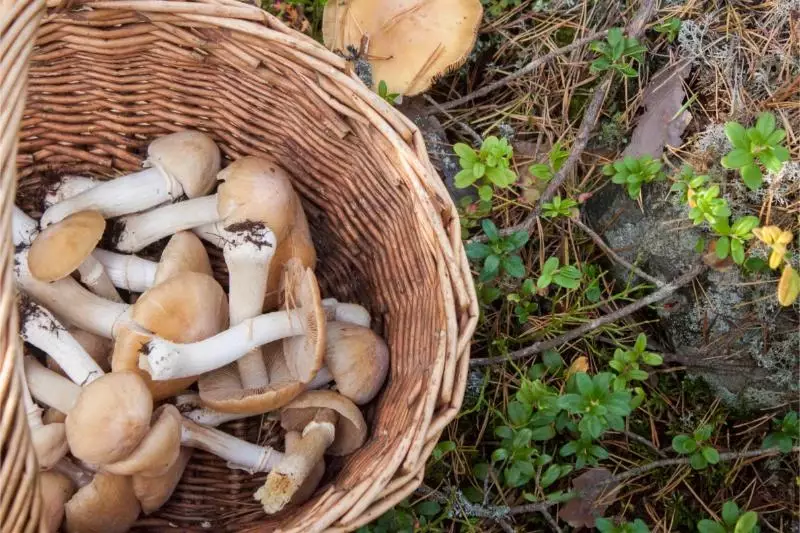
Here's what you need to identify gypsy mushroom:
- Cap: Rusty brown, peels back with age
- Gills: Light then rust with age
- Stem: Bulbous base, whitish
Microscopically, you'll find its spores are brownish and kidney-shaped. The texture of young Gypsy Mushrooms is akin to pasted tissue, and they produce a rusty brown spore print.
Incorporating Cortinarius caperatus into your meals, particularly pasta dishes, adds an earthy and robust flavor that complements rich sauces. Thorough cooking is essential, as it diminishes any mild toxins present when raw.
- Foraging tip: Gypsy mushroom is often found in pine and spruce forests across the Northern Hemisphere, specifically during late summer to fall.
Saffron Milk Cap (Lactarius Deliciosus)
Lactarius deliciosus, also known as the saffron milk cap, is a celebrated edible mushroom. Native to Europe, this vibrant species is also found in North America, often associated with pine trees. Its distinguishing feature is the orange or red cap that, when damaged, secretes a saffron-colored milk.

- Identification: The saffron milk cap has a bright orange to red cap, often displaying concentric zones. Its gills start off pale but turn green as the mushroom ages. The stem shares a similar color to the cap and may have a central depression. When cut, the firm flesh emits an orange milk, further aiding in its identification.
In the kitchen, your saffron milk cap mushrooms add a splash of color and a unique, slightly nutty flavor. They're an integral part of Spanish cuisine, especially in dishes like revueltos (scrambled eggs with mushrooms).
-
Cooking tips: When preparing saffron milk cap mushrooms, it's best to gently brush off any debris before cooking. Ensure thorough cooking by slicing and preparing them properly. In terms of pairing, these mushrooms complement dishes featuring eggs, potatoes, and rich, savory flavors.
-
Storage: You can store saffron milk cap mushrooms in a paper bag in the refrigerator for up to a week. For extended use, you can also preserve them by drying or pickling, allowing for their enjoyment beyond their fresh state.
When you're out foraging, always ensure you've correctly identified these mushrooms before consuming. Their unique features make them a fantastic find for both novice and experienced foragers who enjoy adding wild ingredients to their culinary creations.
Cloud Ear (Auricularia Polytricha)
Auricularia polytricha, also known as Cloud Ear mushroom, is a distinctive fungus that you might find in your Asian cuisine adventures. Remarkably, this edible mushroom has a gelatinous texture and a visually unique ear-like shape, giving it its common name.

Here's what you need to know:
- Appearance: Gray-brown in color, these mushrooms often grow on tree trunks and dead branches in mountainous regions.
- Culinary uses: It's a staple in Asian dishes, prized for its chewy texture that holds up well in soups and stir-fries.
When you prepare Cloud Ear mushrooms, you'll notice their texture is somewhat elastic and silky, contributing a pleasing contrast to dishes with crunchier vegetables or meats. Your culinary experience with this mushroom is bound to be memorable, enhancing flavors while adding a note of intrigue to the presentation of your meal.
- Cooking tip: Before adding to your dish, it's essential to rehydrate dried Cloud Ear mushrooms, as they are often sold in dried form. Just soak them in water until they expand to their original size, which doesn't take long. This simple step is crucial to achieve the desired texture in your final dish.
